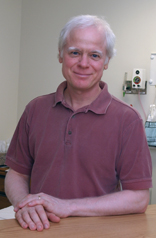 Name: Sam Breidenbach Name: Sam Breidenbach
Home State: Wisconsin
Sam has been participating in clinical research since 2003.
Why? “The ‘standard of care’ at the time did not provide me with the hope I was looking for,” says Sam. “I have always been willing to take certain risks in life and when my life seriously depended upon it, I was willing to explore every option available to me. Clinical Trials to me meant “cutting edge” medical care. Eternal hope was paramount in my decision.”
Sam's story:
A cross country skier for 30 years, 46-year-old Richard “Sam” Breidenbach had always wanted to enter the American Birkebeiner, an arduous 51–kilometer cross country ski race that drew 6,000 skiers this year. Cancer inspired him.
In September 1999, a Madison, Wisconsin, doctor removed a mole on his back that had developed into melanoma, a skin cancer of the worst kind. Two and a half years later it had spread to his left hip and he was treated with interferon, but in March 2003 melanoma cells were found in the lymph nodes in his groin. His skiing buddy, Pete Daly, who was also fighting melanoma, encouraged him to go to the NIH, where Pete was taking part in a cancer vaccine trial. Sam became a research patient of Steven A. Rosenberg, a surgeon–immunologist with the National Cancer Institute who has pioneered in biological approaches to fighting melanoma and renal cell cancer.
Studying melanomas he had removed in surgery, in the mid–1980s Rosenberg had found what looked like immune cells. He wondered if they were there for a reason — and if the body’s immune system could be better harnessed to fight the many cancers that surgery, radiation, and chemotherapy fail to eliminate. Working first on cultures in the laboratory and then on mouse models, he and his research team developed and improved an approach to immune therapy, at each stage establishing the “proof of principle” needed before they could undertake research on humans. This often took years. They showed first on a mouse model and then on human patients the effects of interleukin 2, or IL–2, a natural immune booster. The response rate increased to 15 percent — a notable improvement, but not good enough.
Next, Rosenberg’s lab took tumor-infiltrating lymphocytes (or TIL cells, a form of immune cell) from a tumor and spent 5 years cloning the genes that encode cancer antigens and learning how to generate immune cells called T cells that could recognize them. In other words, they would take the TIL cells out of the patients, expand them, rev them up, and give them back to the patient along with IL–2. They tested this model successfully on patients with far–advanced cases of metastatic melanoma, on whom all standard treatment options had failed.
By the time Sam Breidenbach came along, Rosenberg’s team had added a third crucial step to the therapy: By wiping out the immune system before administering the IL–2 and jazzed–up TIL cells, Rosenberg had increased the response rate for metastatic melanoma patients treated with TIL cells to 50 percent. Many patients still died, but the treatment produced some amazing turnarounds.
Rosenberg tried two or three other approaches to fighting Sam’s melanoma in an effort to buy Sam some time, but his melanoma grew so fast over a 28–day period that by November it had replaced half of his liver and invaded both lungs. Rosenberg’s lab was trying to grow Sam’s immune cells in culture, but Sam’s future looked short and bleak.
Sam, who was trying to sustain a business restoring and renovating houses, was still weighing his options when the cells finally began to respond — aggressively. On Thanksgiving, Sam and his family were preparing to leave for dinner with relatives when the phone rang. “Your cells are jumping out of the petri dish,” Rosenberg told Sam, with barely concealed excitement. “You have to come in. We want you here Monday.”
In early December Sam went through 7 days of chemo to wipe out his immune system, so it wouldn’t compete with the new jazzed–up lab–grown immune cells. “On the seventh day, they injected me with my new cells — half of them through a catheter into the main artery into my liver and the other half through the port they’d used to administer chemo.”
The treatment felt rough to Sam — especially three days of IL–2, which induced nausea and gave him bizarre dreams. Pete, visiting to cheer him up, proposed that they sign up for the Birkebeiner, a tough race even for skiers in good condition. Life itself was tenuous and Sam felt so weak that just getting out of bed was an accomplishment.
A week and a half after Sam got home from Bethesda, his strength returned almost full force. He began skiing a little. Scans done at the Clinical Center a month later showed that 80 percent of his tumors were gone. A month or two later the cancer was gone completely.
And so, 71 days after beginning treatment for a melanoma that had replaced nearly half his liver, Sam and his buddy Pete took on the Birkebeiner. February 21, 2004, was a beautiful day for skiing. At about 30 kilometers they both considered getting on a bus and cutting their race short, but they decided to finish “just to have fun and be with one another.” It took them 7 hours, 13 minutes, and 57 seconds to ski 31.7 miles, but they went the distance.
And Sam is still showing no signs of cancer.
Read more stories
|